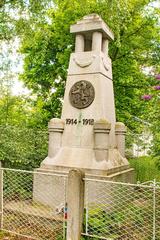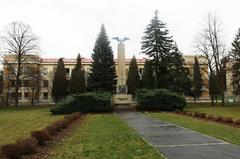Automatické Mlýny Pardubice: Visiting Hours, Tickets, and Guide to Historical Sites in Czechia
Date: 14/06/2025
Introduction
Automatické Mlýny in Pardubice is a landmark of Czech industrial heritage, renowned for its striking architecture, rich history, and dynamic cultural revival. Originally established as a milling site in the late 16th century, it gained national prominence under the Winternitz family and was transformed into a masterpiece of early 20th-century modernism by architect Josef Gočár. Today, the revitalized complex serves as a vibrant center for art, education, and community engagement, attracting both locals and visitors to experience its unique blend of historical significance and contemporary vitality (Toulavé Šlápoty; Expats.cz; fajnvylety.cz).
This comprehensive guide details the site’s historical evolution, architectural highlights, visitor information, current offerings, and future developments—ensuring you make the most of your journey to one of Pardubice’s and Czechia’s most inspiring destinations.
Table of Contents
- Early Milling Traditions and Origins
- Josef Gočár’s Architectural Vision
- Industrial Expansion and National Importance
- Decline and Transformation
- The Smetana Foundation and Revitalization
- Key Architectural Features
- Adaptive Reuse and Modern Interventions
- Visiting Information: Hours, Tickets, Tours
- Attractions and Institutions Onsite
- Accessibility and Amenities
- Nearby Attractions
- Cultural and Community Events
- Future Developments (2023–2026)
- FAQs
- Visual Suggestions
- Conclusion
- References
Early Milling Traditions and Origins
The Automatické Mlýny site has been central to Pardubice’s economy since at least 1586, serving as a vital milling center for centuries. The 19th-century stewardship of the Winternitz family set the stage for the transition from a traditional mill to a technologically advanced industrial complex (Toulavé Šlápoty). Mills such as these were not only food production facilities but also served as economic and social anchors in their communities.
Josef Gočár’s Architectural Vision
Commissioned in the early 20th century, Josef Gočár—one of Czechia’s foremost architects—designed the new mill complex between 1909 and 1911, incorporating modernist and functionalist principles. Drawing inspiration from the Ishtar Gate of Babylon, Gočár’s vision is evident in the monumental brickwork, grand archways, and harmonious integration of industrial and artistic elements (fajnvylety.cz; Expats.cz; gocarovagalerie.cz).
Industrial Expansion and National Importance
Upon its completion, Automatické Mlýny was among the largest and most technologically advanced mills in the Czech lands. It played an essential role in supplying flour to Eastern Bohemia, underlining its economic and strategic relevance. The site earned recognition as a national cultural monument, further cementing its status in Czech history (fajnvylety.cz).
Decline and Transformation
Modernization in the food industry and shifting economic landscapes led to the closure of milling operations in 2013. The site faced neglect and the threat of unsympathetic redevelopment until its 2016 acquisition by Lukáš and Mariana Smetana (Expats.cz).
The Smetana Foundation and Revitalization
The Smetanas, in partnership with local authorities, spearheaded a comprehensive restoration, preserving Gočár’s architectural integrity and transforming Automatické Mlýny into a multifunctional cultural and community hub. Completed in 2023, the project drew from European funding and exemplified best practices in adaptive reuse (Expats.cz; automatickemlyny.eu).
Key Architectural Features
- Materiality: Exposed red and grey brickwork creates a rhythmic, sculptural façade, referencing both Cubist tendencies and industrial tradition (gocarovagalerie.cz).
- Monumental Arch: The signature arch linking the main building and silos symbolizes the fusion of historic grandeur with industrial function.
- Silo Integration: The 1924 cylindrical silos harmonize with the rectangular mill through consistent materiality.
- Functional Layout: Gočár’s design prioritized workflow, daylight, and robustness—now celebrated in interpretive displays onsite (estateandbusiness.cz).
Adaptive Reuse and Modern Interventions
The restoration, led by leading Czech studios, focused on minimal intervention and the careful removal of non-original additions. Historical milling machinery was preserved as exhibit pieces, and new functions were sensitively integrated to respect the site’s unique character (gocarovagalerie.cz; estateandbusiness.cz; earch.cz).
Visiting Information: Hours, Tickets, Tours
- Opening Hours: Most galleries and public spaces are open Tuesday–Sunday, 10:00–18:00 (closed Mondays).
- Tickets: General admission to exhibitions ranges from 80–150 CZK; discounts for students, seniors, and groups. Outdoor areas and many events are free (automatickemlyny.eu).
- Guided Tours: Available on weekends or by appointment, focusing on architecture, history, and industrial heritage (visitpardubice.com).
- Accessibility: Full barrier-free access, including ramps, elevators, tactile guides, and induction loops.
Attractions and Institutions Onsite
- Gočár Gallery: Regional art exhibitions, educational studios, lecture hall, and rooftop terrace (automatickemlyny.eu).
- GAMPA: Municipal contemporary art gallery in the former flour warehouse.
- Sféra: Technology and craft education center with workshops and labs.
- Silo: Foundation headquarters, visitor center, multifunctional hall, tourist information, and rooftop views.
- Public Spaces: Landscaped parks, inner squares, and the riverfront for relaxation and events.
Accessibility and Amenities
- Food & Drink: Café Gočár (open daily 8:00–21:00), rooftop bar during events, and regular street food pop-ups.
- Information: Tourist Information Centre in Silo provides maps, event schedules, and merchandise.
- Location: Mezi Mosty 436, 530 03 Pardubice—walkable from the historic center, accessible by public transport and bike.
Nearby Attractions
Automatické Mlýny is ideally situated for exploring other Pardubice landmarks, including Pardubice Castle, the Green Gate, East Bohemian Museum, and the riverside promenade—all within a short stroll.
Cultural and Community Events
The complex hosts a lively calendar of exhibitions, markets (e.g., MINT Market), concerts, theater performances, creative workshops, and seasonal festivals, drawing visitors of all ages (kudyznudy.cz).
Future Developments (2023–2026)
The second phase, underway through 2026, will add residential, commercial, and civic buildings—designed by Zette atelier—to complete the urban quarter (pardubice.eu; designmag.cz). Expanded public spaces, enhanced riverfront integration, and a deepened commitment to sustainability are central to this vision (otevrenakultura.cz).
Frequently Asked Questions (FAQs)
Q: What are the visiting hours?
A: Tuesday–Sunday, 10:00–18:00; closed Mondays. Some amenities may have extended hours during events.
Q: Is entry to public spaces free?
A: Yes, outdoor areas are free; gallery exhibitions may require a ticket.
Q: Are guided tours available?
A: Yes, on weekends or by appointment.
Q: Is the site accessible for people with disabilities?
A: Absolutely—barrier-free access is provided throughout the complex.
Q: How do I get there?
A: Walk from the city center, take public transport (bus lines 3, 8), or use nearby parking.
Visual Suggestions
- Feature high-resolution images of the Gočár Gallery façade, Silo rooftop, and landscaped park.
- Use alt tags such as “Automatické Mlýny Gočár Gallery facade in Pardubice” and “Rooftop terrace view at Automatické Mlýny.”
- Embed an interactive map from the official website.
- Suggest a virtual tour link for remote visitors.
Conclusion
Automatické Mlýny is a living testament to the power of adaptive reuse, blending iconic architecture, historical depth, and contemporary cultural vibrancy. Whether you are drawn by its artistic programming, educational workshops, or picturesque cityscape, the site is an essential stop for anyone interested in Czech heritage and innovation. Stay updated on exhibitions, events, and new developments by following the official website, downloading the Audiala app, and exploring related articles on Pardubice’s cultural landmarks.
References
- Toulavé Šlápoty
- Expats.cz
- fajnvylety.cz
- gocarovagalerie.cz
- estateandbusiness.cz
- earch.cz
- pardubice.eu
- automatickemlyny.eu
- kudyznudy.cz
- designmag.cz
- otevrenakultura.cz
- visitpardubice.com


